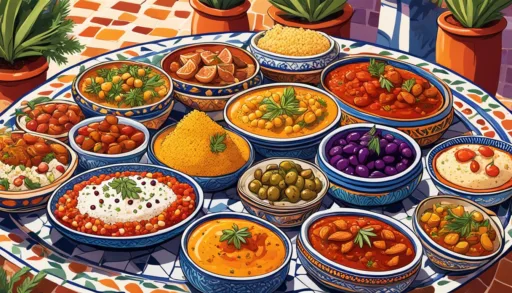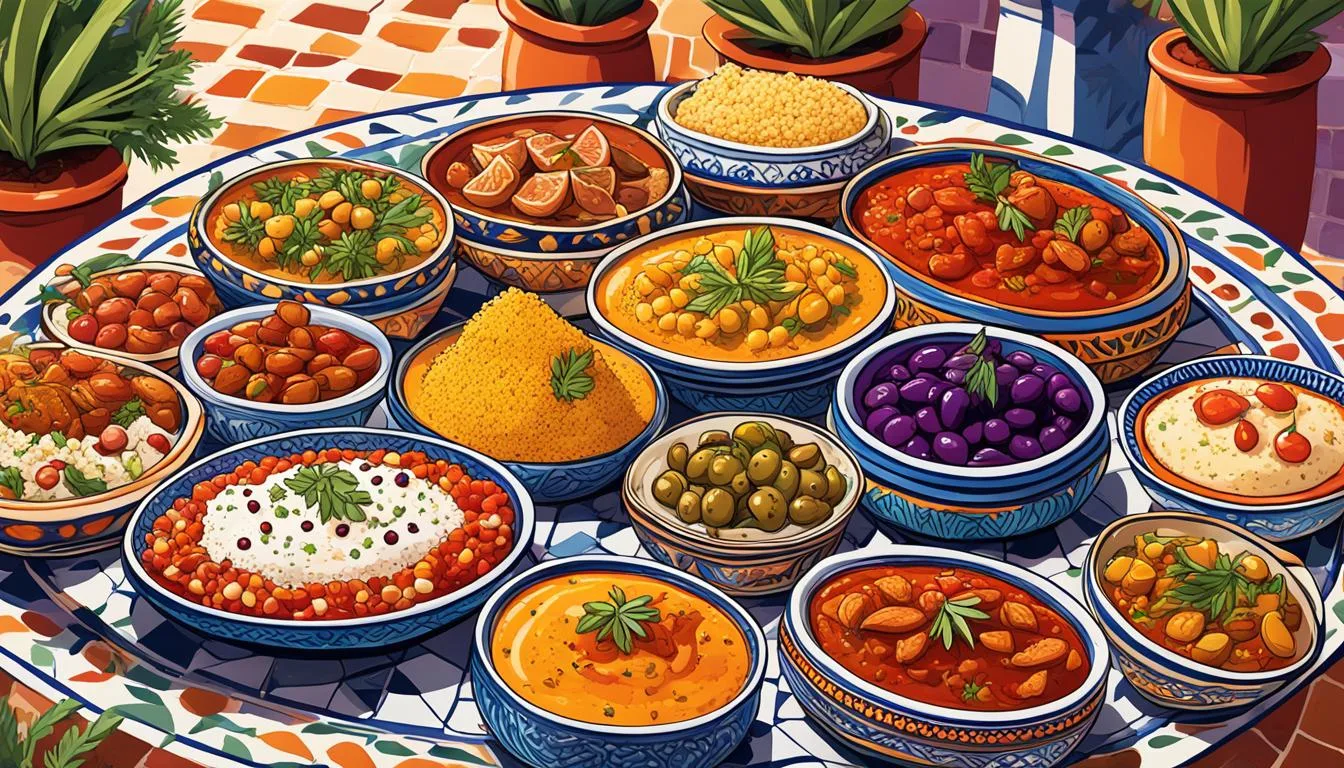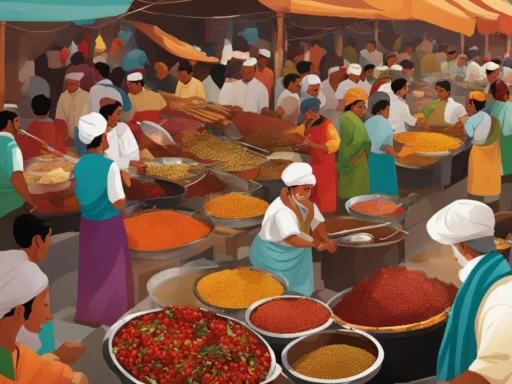Imagine unlocking the secrets to a treasure trove of flavors, where every bite takes you on a voyage through spice-scented markets and along sun-drenched Mediterranean shores. Do vivid colors, enticing aromas, and rich histories pique your interest? Then join us as we embark on a fascinating journey through the Tunisian Food Guide, your portal to the heart of Tunisian cuisine. Taste the harmony in diversity with traditional Tunisian dishes that paint a picture of this nation’s alluring culinary traditions of Tunisia.
From the bustling alleyways of Tunis to the serene olive groves of the countryside, Tunisia’s culinary heritage serves a banquet of mouthwatering delights. Unveil the gastronomic narrative that threads together Berber traditions, Ottoman extravagance, and French sophistication into a tapestry of tastes that define Tunisian culture. Step into Tunisia’s kitchens and let your palate be guided by centuries-old recipes passed down through generations and refined to perfection.
Key Takeaways
- Discover the diverse influences that shape Tunisian cuisine and how they reflect the country’s rich history.
- Experience the unique ingredients and spices that are the cornerstones of Tunisian culinary traditions.
- Explore the essential traditional Tunisian dishes that offer a window to the nation’s soul.
- Learn about Tunisia’s dedication to communal dining as a testament to its warm and inviting food culture.
- Gain insights into the significance of authenticity and innovation in Tunisian gastronomy for food enthusiasts.
Taste of Tunisia: An Introduction to Tunisian Cuisine
Embarking on a flavorful journey through Tunisian food culture is akin to exploring a treasure trove of sensory delights. The country’s cuisine is renowned for its harmonic blend of spices, such as cumin, coriander, and paprika, which are deeply rooted in centuries of tradition and trade. Key to these authentic Tunisian recipes is harissa, a fiery paste that encapsulates the spirit of Tunisia and graces everything from grilled meats to vegetable dishes.
Staples such as couscous and lamb are testament to Tunisia’s pastoral heritage, while the abundant seafood speaks of its Mediterranean shoreline. Olive oil, a liquid gold in Tunisian gastronomy, serves as the foundation for many dishes, illustrating the importance of quality, local ingredients. As we delve into the multilayered Tunisian palate, lentils, almonds, and tomatoes are just a few of the elements that contribute to the diverse array of tastes and textures that Tunisian cuisine has to offer.
The beauty of Tunisian cuisine lies in the intricate dance of flavor and simplicity – a cuisine that has evolved with its people and echoes the multitude of civilizational influences that have touched this land.
- Couscous – The national dish, often accompanied by a rich stew
- Lamb – A chief ingredient, celebrated for its tenderness and flavor
- Seafood – Fresh from the Mediterranean, a staple in coastal regions
- Harissa – The linchpin of Tunisian flavor, vibrant and versatile
- Olive Oil – The pure, heart-healthy base of Tunisian cooking
- Legumes and Nuts – Integral to the diverse vegetarian options
- Fresh Vegetables – Tomatoes and more, bringing color and nutrition
Discovering the essence of Tunisian dishes means appreciating the intricate ways in which these elements combine to form a culinary mosaic as rich and inviting as the country itself. The depth of authentic Tunisian recipes and fervent embrace of the historical and contemporary signifies a food culture that is vibrant, enduring, and ready to be explored.
The Tunisian Food Guide: Essential Dishes to Try
Visiting Tunisia offers an array of tantalizing flavors, each dish conveying the nuances of an age-old culinary tradition. In this guide, we focus on bringing to the forefront some of the most traditional Tunisian dishes, sought out not only in the best Tunisian restaurants but also the vibrant world of Tunisian street food.
Discovering the Beloved Couscous
Couscous, the national dish of Tunisia, is a beloved staple that is far more than just a meal—it is a symbol of warmth and hospitality. This versatile dish is lovingly prepared with a fluffy bed of steamed granules of durum wheat and typically served with a rich stew. Whether you indulge in a plate topped with lamb, chicken, or an assortment of vegetables, couscous remains a definitive experience in the spectrum of traditional Tunisian dishes.
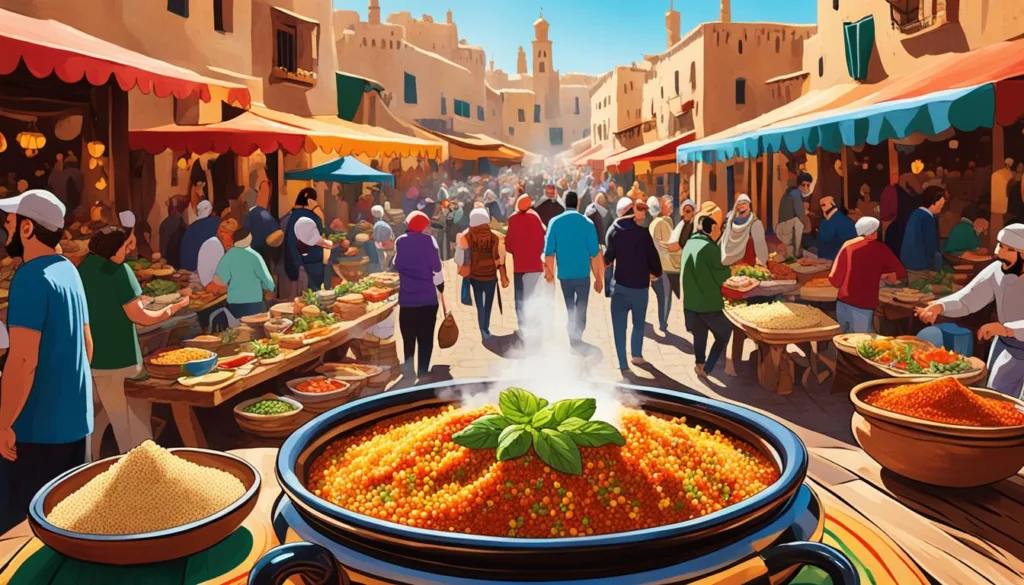
Indulgence in Brik: A Tunisian Delight
The iconic Brik is a Tunisian street food that has garnered love from locals and travelers alike. This deep-fried pastry is a harmonious blend of texture and taste, typically filled with a whole egg, some parsley, and onions, and often includes tuna. Its crispy exterior breaks into a rush of sapid flavors, making it an irresistible snack at any time of the day.
Mechoui: A Feast for the Senses
For those with a hearty appetite, Mechoui is the answer. A celebration of meat at its most primal, Mechoui features slow-roasted lamb cooked over an open fire until it reaches succulent perfection. Seasoned simply with salt and local spices, it’s a rich and captivating dish that’s a testament to Tunisia’s deep-rooted love for grilled meats.
Each of these dishes tells a story of Tunisia’s history, culture, and culinary excellence. From traditional homes to the bustling streets, these culinary gems provide a taste of Tunisia that you will not forget. So, the next time you’re searching for an authentic Tunisian meal, make sure to include these delectable dishes on your must-try list.
Unpacking the Spice Rack: Popular Tunisian Spices and Their Uses
The tapestry of Tunisian culinary traditions is intricately woven with an assortment of popular Tunisian spices that add depth and vibrancy to its cuisine. These spices are the backbone of Tunisian gastronomy, infusing dishes with distinctive flavors that resonate with the spirit of North Africa.
Harissa, undoubtedly the superstar, is a testament to Tunisian love for heat. It is crafted from chili peppers, garlic, and a blend of spices, and is used to kick up the flavor in everything from soups to grilled meats. Below is a guide that delves into some of the most beloved spices and their uses in Tunisian cookery.
| Spice | Description | Common Uses |
|---|---|---|
| Harissa | A fiery chili paste | Sauces, marinades, stews |
| Cumin | Earthy and warming | Rubs, soups, couscous |
| Coriander | Citrus-like and sweet | Meat dishes, salads, pastries |
| Mint | Fresh and aromatic | Teas, salads, dips |
| Paprika | Smoky and mild | Grilled foods, soups, stews |
Each of these spices carries a slice of history and tradition, passed down through generations within Tunisian families. They continue to play a pivotal role in Tunisian culinary traditions, turning ordinary ingredients into spectacular feasts that are an invitation to explore the rich palette of Tunisian flavors.
Traditional Tunisian Meals: A Dive into Authenticity
The heart and soul of Tunisian food culture is expressed through its meals, which offer a true taste of place and tradition. As an emblem of the country’s rich gastronomic history, traditional Tunisian dishes invite diners on a flavorful journey from the first light of day until the evening’s calm.
Preserving time-honored customs, Tunisian cuisine serves as a daily manifestation of the nation’s cultural identity, with each region presenting its own unique symphony of flavors, ingredients, and preparations that are shaped by both heritage and geography.
From Breakfast to Dinner: Typical Tunisian Food Times
With the break of dawn, Tunisians often greet the day with light yet delightful pastries and bread, each morsel reflecting the simple pleasures of the local food scene. As the sun ascends, the midday meal emerges as the principal event, often featuring a robust lamb couscous, brimming with savory broth and tender vegetables.
As shadows lengthen and dusk approaches, dinner tables are graced with the vibrant hues and bold tastes of Chakchouka, a spicy tomato-based dish that embodies the fiery spirit of the Tunisian palate.
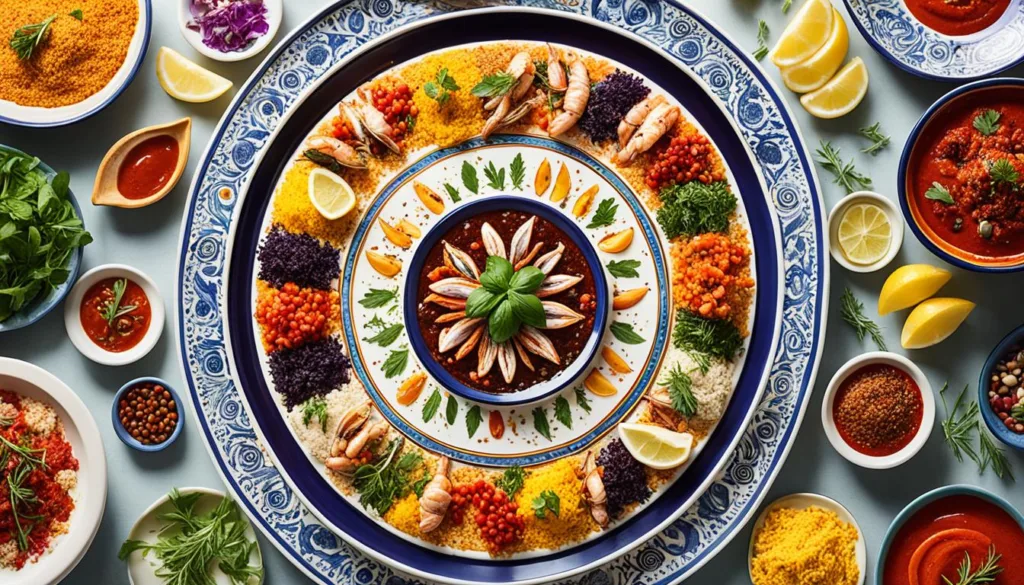
Regional Variations in Tunisian Cuisine
The country’s varied landscapes foster an impressive diversity in traditional Tunisian meals. Coastal towns, with their bountiful access to fresh fish and shellfish, pride themselves on crafting exquisite seafood dishes that echo the rhythm of the Mediterranean.
Conversely, the inland regions with their robust agricultural foundations place an emphasis on heartier fare, spotlighting the rich flavors of game meats and locally-sourced vegetable stews that evoke the earthiness of Tunisian terrain.
Embracing the full spectrum of Tunisian food culture, these regional specialties contribute to the intricate mosaic that makes Tunisian cuisine not just an act of eating, but an art form deeply woven into the tapestry of Tunisian life.
Tunisia’s Culinary History: Influences and Evolution
The Tunisian cuisine we savor today is an exquisite tapestry, woven through time with threads of diverse Tunisian culinary traditions and international influences. It is a history rich with tales of conquests, cultural exchanges, and the glorification of local staples, underpinning the seamless fusion found in Tunisian dishes.
From the ancient Phoenician traders introducing the nuances of grape cultivation to Carthaginian settlements sharing agricultural prowess, each epoch added a new dimension to Tunisian gastronomy. The Arab conquest brought with them the refined flavors of sweetened desserts and aromatic spices, while Ottoman rule left imprints of sumptuous pastries and richly layered dishes.
Tunisian palate underwent a remarkable transformation with the arrival of the French, bringing techniques of baking and sauced meats, forever altering the food landscape. Post-independence saw a revival and a fierce preservation of quintessential Tunisian characteristics, marrying them with modern culinary practices.
Integral traditions remain preserved, while newer influences seamlessly blend into the gastronomic canvas that has evolved gracefully through centuries of cultural interchange.
- Phoenician influences instilled an appreciation of fermented sauces and seafood.
- Berber dishes relied on native grains, highlighting Tunisia’s agricultural bounty.
- The Arab and Ottoman impact introduced an assortment of spices, enriching the flavors of Tunisian cuisine.
- French culinary methods brought structure and a new eye for pairing wines with meals.
Today’s Tunisian cuisine is not just a reflection of its elaborate past but a celebration of its ability to adapt and evolve. Gourmands and culinary enthusiasts continue to explore Tunisia’s edible archives, uncovering the rich history and ongoing evolution that make Tunisian dishes a vibrant part of global cuisine.
The Heart of Tunisian Food Culture: Family and Festivities
In Tunisia, the rich tapestry of Tunisian food culture extends far beyond mere sustenance—it is a testament to the nation’s beating heart, woven into the social fabric of everyday life and the grandeur of special occasions. The collective nature of meals fosters an environment where families and friends gather to enjoy dishes steeped in Tunisian culinary traditions, turning each meal into a vivacious cultural dialogue.
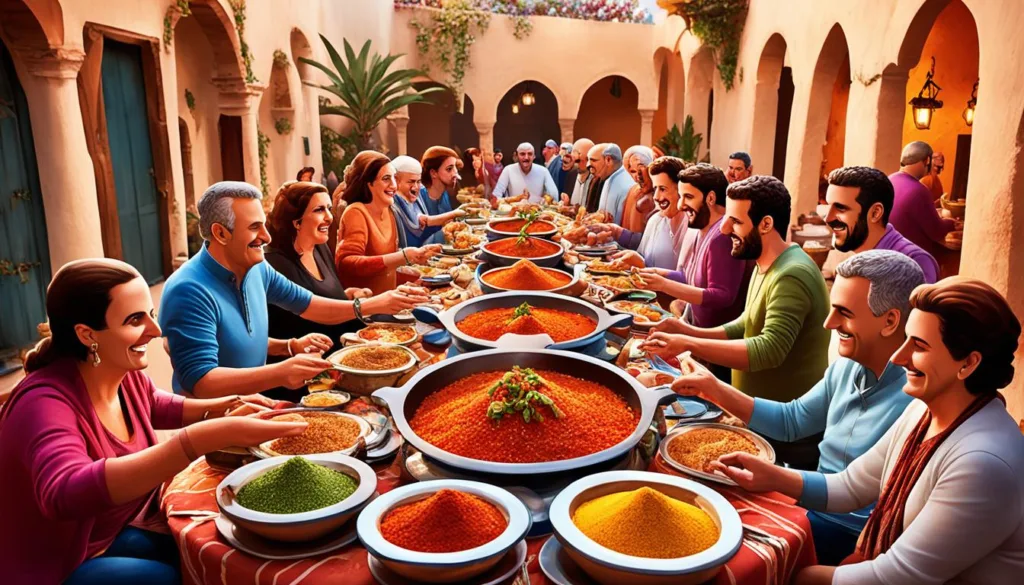
The Role of Food in Tunisian Social Life
To truly immerse oneself in Tunisian traditions, one must understand the significance of food within its social setting. The diversity of Tunisian cuisine is not only found on the plate but also in how it manifests as a form of hospitality, a medium for celebration, and most notably, an expression of community. This facet of the Tunisian food guide underlines the interweaving of culinary delights with the heartstrings of familial and societal bonds.
Tunisian Festive Foods: A Guide to Celebration Cuisine
Festive occasions in Tunisia are spectacles of culinary finesse, and certain dishes grace the tables more prominently when celebrating. The conclusion of the month of Ramadan, for instance, sees tables adorned with sweet and savory dishes symbolizing the end of fasting and the joy shared amongst loved ones.
| Festival | Main Dishes | Desserts |
|---|---|---|
| Eid al-Fitr | Lamb preparations | Mhalbi, Baklava |
| The Prophet’s Birthday | Merguez, Brik | Assida |
| Weddings | Couscous, Fish | Bjaouia, Makroud |
Each joyous event is marked by a feast where the legacy of Tunisian recipes comes to life, reaffirming the maxim: to taste their food is to explore their culture, and to partake in their festivities is to become a part of their family.
Culinary Innovations: Fusion and Future Trends in Tunisian Cuisine
The realm of culinary innovations in Tunisia is progressing at a tantalizing pace, as chefs merge quintessential flavors with contemporary techniques. Reflecting a blend of old and new, modern Tunisian cuisine promises an experience that honors tradition yet thrives on progression. This dynamic interplay of tastes is setting the stage for a new era in the country’s gastronomic narrative.
Creative Tunisian cooks are at the forefront, working with an array of homegrown herbs and spices to craft dishes that offer a nod to the past while embodying the essence of innovation. Ingredients familiar within Tunisian borders are being reimagined, keeping authenticity intact as they cater to modern palates. The result is a harmonious blend of tastes that confidently steps onto the global culinary scene.
| Traditional Ingredient | Innovative Interpretation | Resulting Culinary Creation |
|---|---|---|
| Couscous | Infused with international flavors | Couscous bowls featuring Asian spices or Italian herbs |
| Harissa | Applied in unconventional dishes | Harissa-marinated chicken sliders |
| Seafood | Paired with unexpected textures | Seafood terrine with saffron and citrus zest |
| Lamb | Slow-cooked with global spices | Tandoori lamb shank |
A vibrant future awaits Tunisian gastronomy, one where diners are invited to witness a confluence of taste that transcends borders. The essence of Tunisian hospitality remains, while flavors are emboldened, proving that the heart of Tunisian culinary tradition continues to beat strong—even as it explores new horizons.
Top Tunisian Food Blogs and Resources to Follow
For enthusiasts eager to delve into the flavors of North Africa, an array of digital resources stands ready to transport your senses straight to the heart of Tunisia’s culinary tradition. The internet is abuzz with top Tunisian food blogs that provide not only authentic Tunisian recipes but also unique insights into the fabric of Tunisian food culture. These online havens are a goldmine for both the curious and the culinary adventurer, offering vivid portrayals of traditional and contemporary dishes through virtual tours and detailed recipe guides.
Virtual Tours of Tunisia’s Kitchens
Immersive virtual experiences invite you to step into the buzz of a Tunisian market or the warmth of a home kitchen in Carthage. Through beautiful photography and engaging storytelling, these blogs provide a behind-the-scenes look into the preparation of delectable dishes like the spicy and hearty “Lablebi.” From simmering pots of fragrant “Tagine” to artfully plated “Debla,” these visual stories translate into a deeper appreciation of Tunisia’s rich gastronomical tapestry.
Best Cookbooks for Mastering Tunisian Dishes
Those seeking a hands-on approach will find great companions in cookbooks dedicated to Tunisian cuisine. Compact with authentic Tunisian recipes, these tomes are curated to help you recreate the magic of Tunisian flavors in your own dwelling. With step-by-step instructions, they simplify the art of Tunisian cooking, demystifying dishes like the beloved “Brik” and the sumptuous “Makroudh.” Embrace the opportunity to cook up a Tunisian storm with guidance from these culinary bibles, celebrating a cuisine that is both diverse and deeply satisfying.
